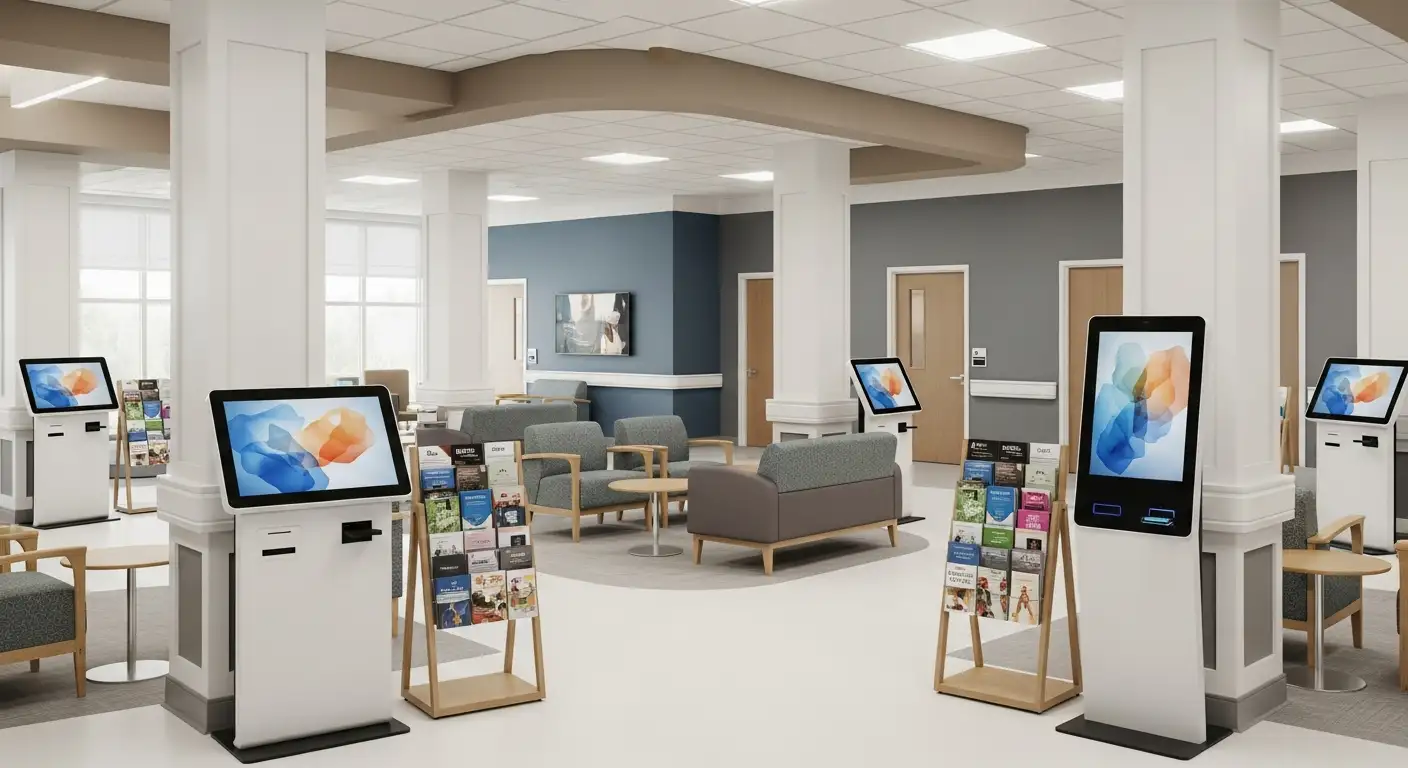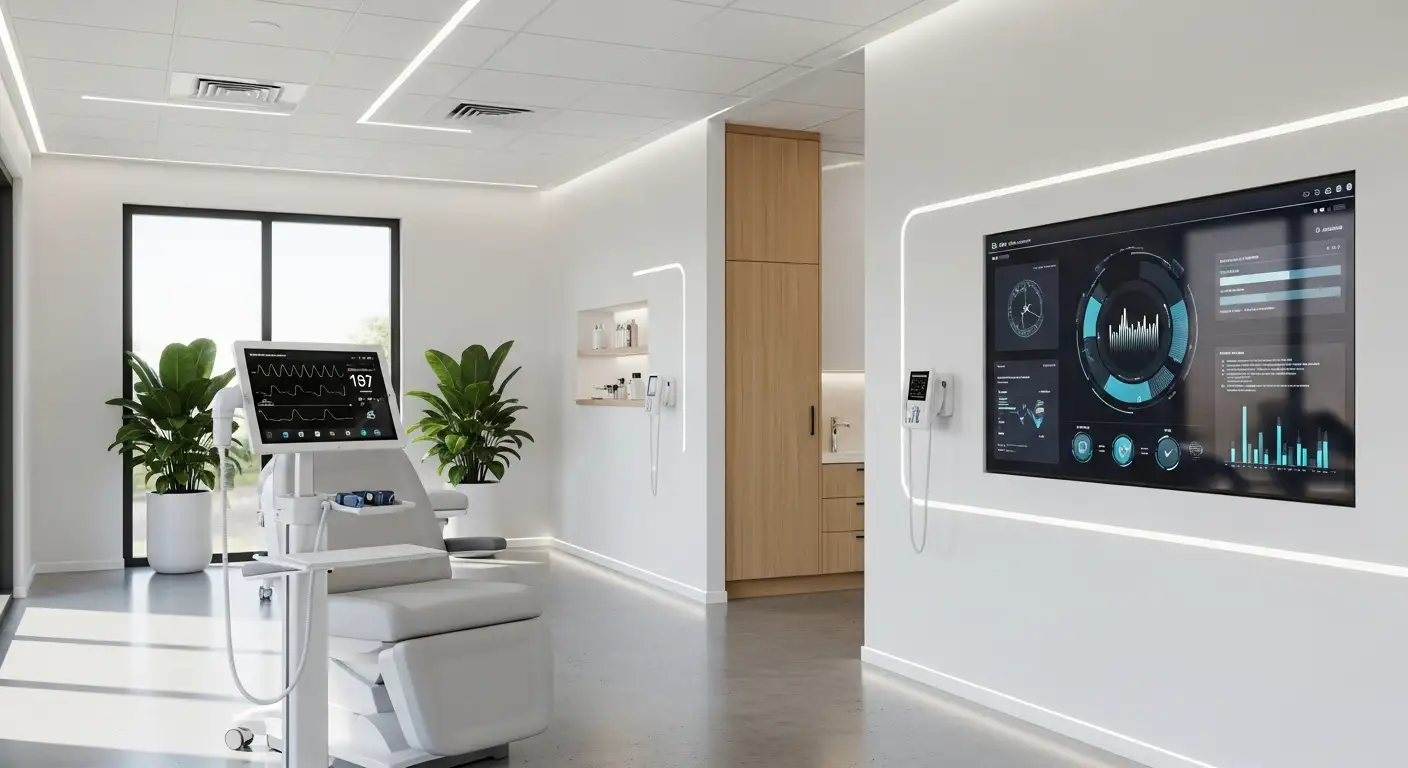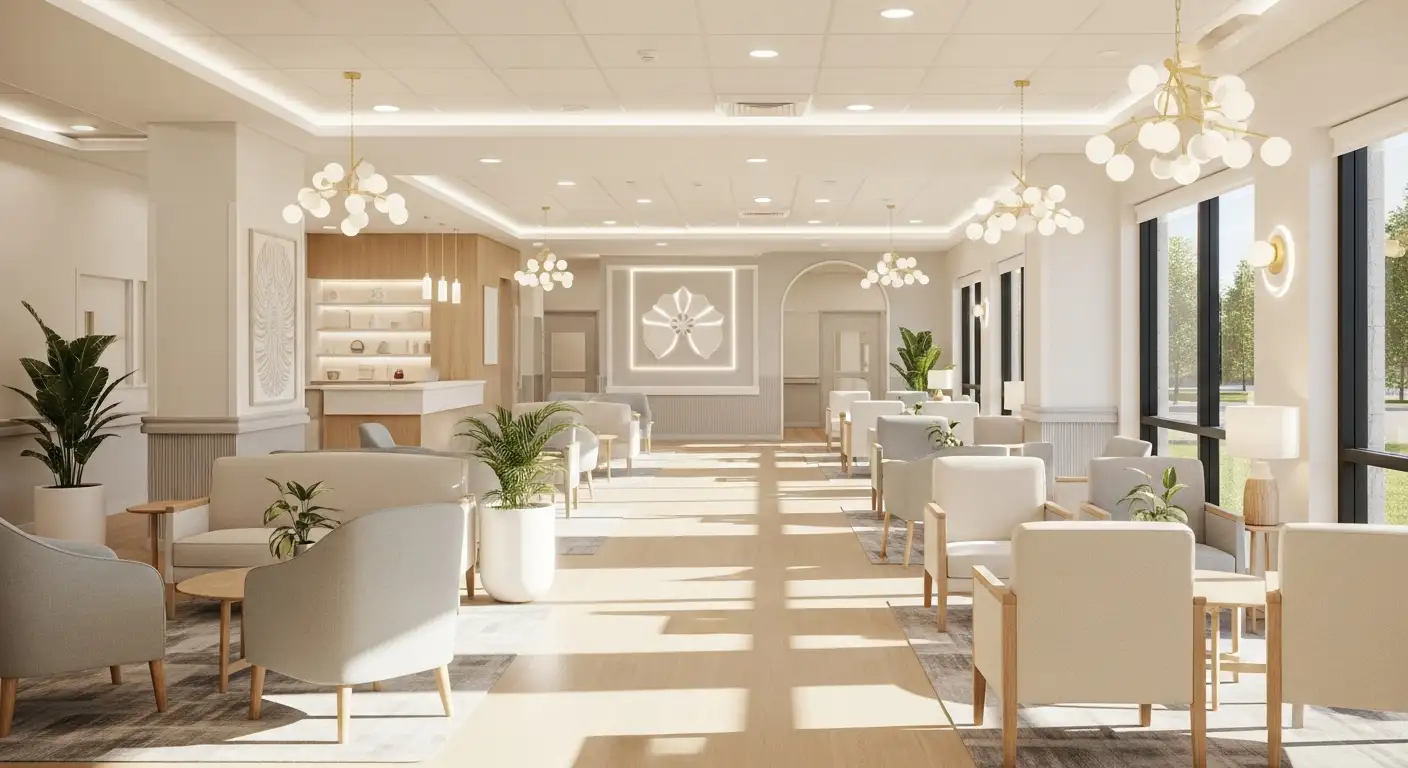The Trouble with Sporadic Health Monitoring in Seniors
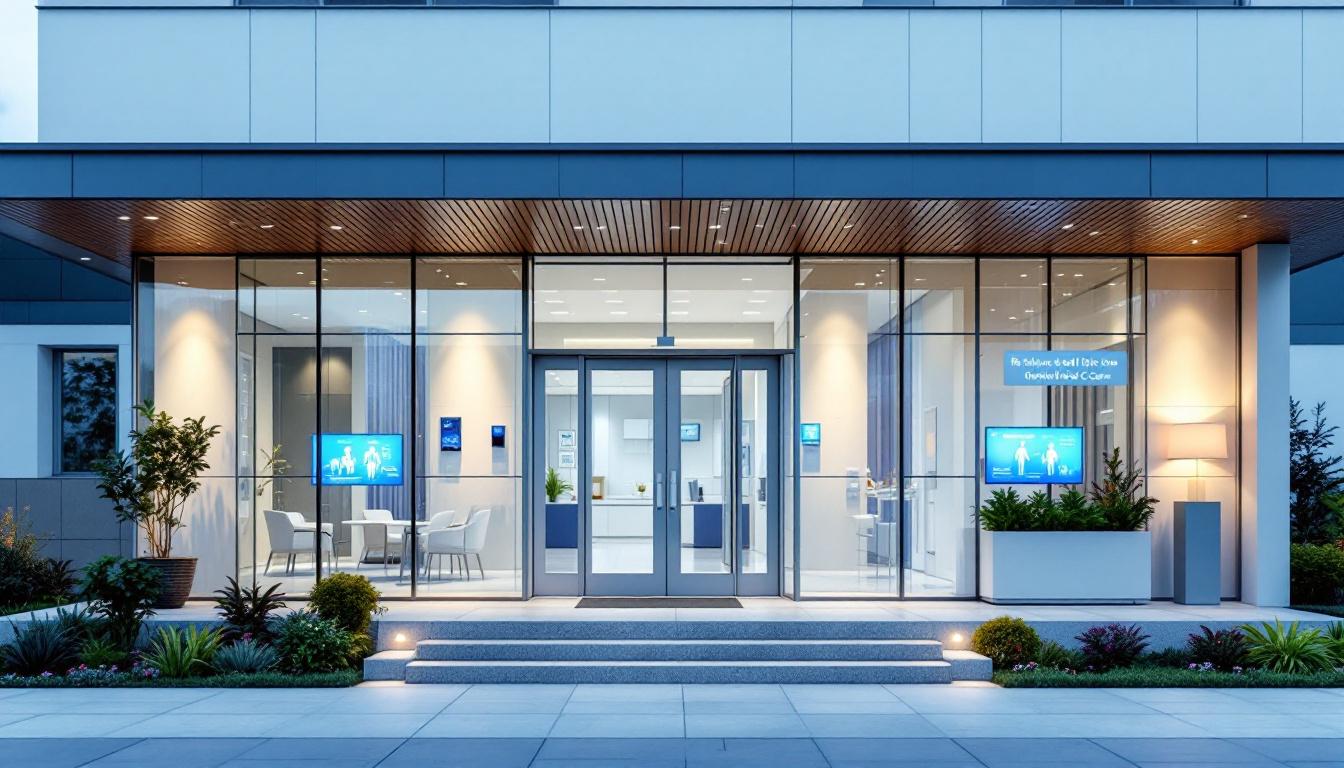
Addressing the Gaps in Senior Health Surveillance
The increasing aging population necessitates reliable health monitoring systems to safeguard the well-being of seniors. Despite technological advancements, sporadic and inconsistent health data collection remains a significant barrier to effective elderly care, posing risks to timely intervention and accurate health assessment.
Common Health Problems Faced by Elderly Individuals
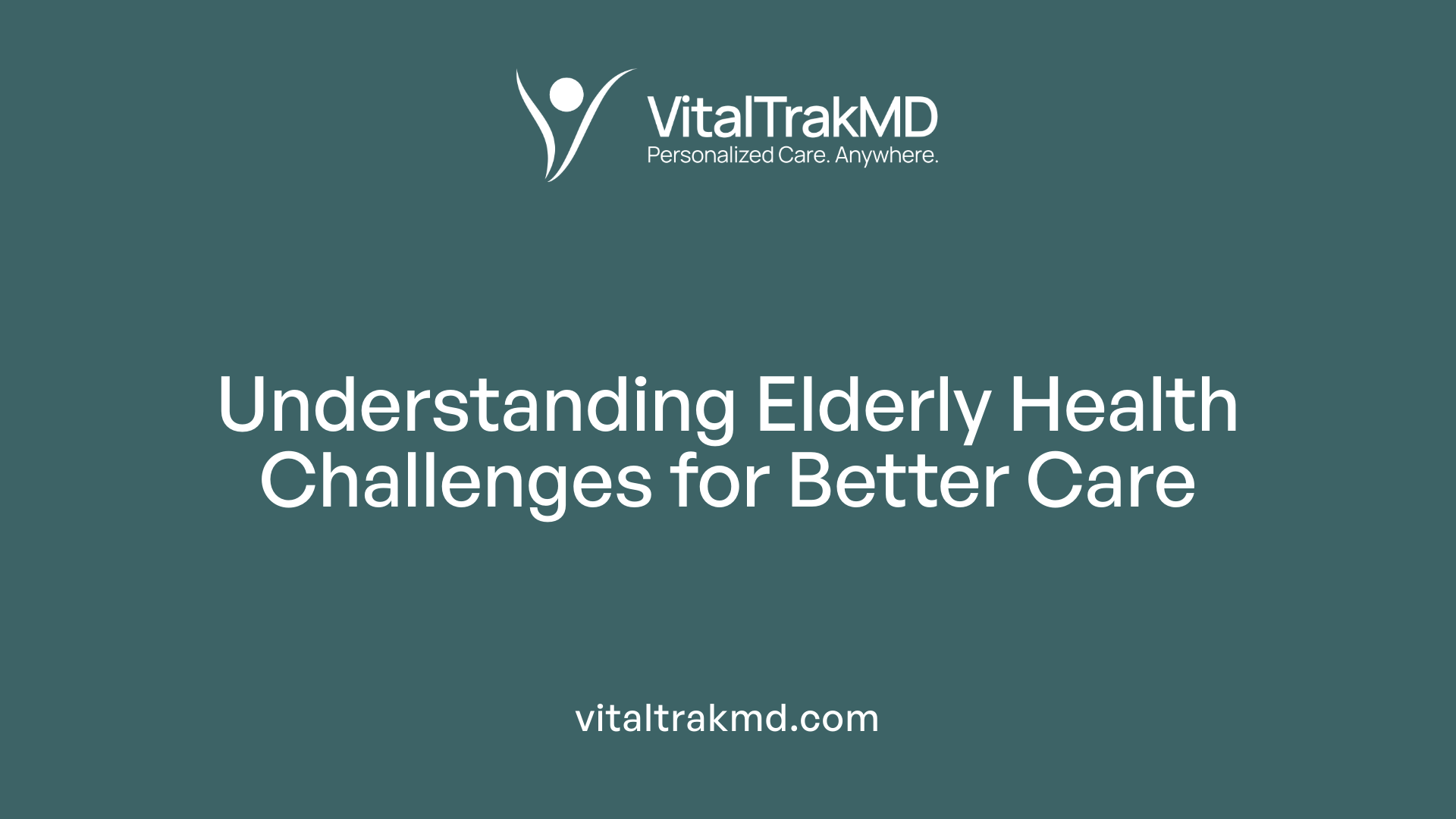
What are the common health problems faced by elderly individuals?
Elderly populations encounter a variety of health issues that significantly impact their quality of life and independence. Age-related sensory impairments are widespread, with many experiencing hearing loss and visual problems like cataracts or refractive errors. These impairments can lead to social isolation and increased risk of accidents.
Musculoskeletal issues are also common. Conditions such as osteoarthritis, back and neck pain, and decreased bone density contribute to mobility challenges and higher fall risk among older adults. These problems often result in fractures and long-term disability.
Chronic diseases such as hypertension, diabetes, cardiovascular diseases, and chronic obstructive pulmonary disease (COPD) are prevalent in the elderly. Managing these conditions requires ongoing monitoring and medical attention to prevent complications and maintain functional ability.
Geriatric syndromes like frailty, urinary incontinence, falls, delirium, and pressure ulcers are significant concerns. These syndromes not only affect health status but also increase dependence on caregivers and healthcare systems.
Mental health conditions are increasingly recognized as critical issues. Depression and dementia are common and often underdiagnosed, leading to further cognitive decline and emotional distress.
To address these challenges, innovative health monitoring systems employing sensor technology and telehealth tools are being developed. These systems aim to detect early signs of deterioration, facilitate continuous health assessment, and support independent living.
How do modern sensor systems improve elderly healthcare?
Recent advancements in sensor-based monitoring integrate wearable devices, passive infrared (PIR) motion sensors, and mobile applications to track elderly health parameters continuously. For example, Bluetooth Low Energy (BLE) tags worn by residents, combined with PIR motion sensors, can accurately locate individuals and monitor their activities.
These systems can discriminate residents' identities with up to 96% accuracy using decision tree classifiers. While movement detection accuracy decreases with distance, they are effective in providing valuable real-time data on activity levels.
Data collected through sensors, such as heart rate, location, steps, and sleep patterns, can be fused with mobile app information for a comprehensive understanding of a senior’s health status. This fusion allows for more insightful assessments, identification of health risks, and timely interventions.
How effective are these technologies in real-world scenarios?
Field tests in real home environments demonstrated that sensor systems could monitor two older adults over a week, gathering data on daily activity levels and habits. Such data enable calculations of metrics like Daily Activity Level (DAL) and Daily Room Activity (DRA), essential for understanding mobility and routine patterns.
The overall ability to correctly identify individual residents during supervised testing reached 76%, illustrating promising accuracy for practical applications.
Implementing these technologies aligns with strategies to promote active aging, prevent cognitive and physical decline, and reduce social isolation. In addition, contactless digital measures have been developed, providing extensive health information comparable to wearable sensors and addressing issues related to user burden.
How do these systems support health and independence?
Integrating sensors with mobile apps and wearable devices eases long-term health monitoring, making it less intrusive and more sustainable. These tools help detect early signs of health deterioration, such as fall risk, frailty, or early cognitive impairment.
An example includes a comprehensive digital exhaust composed of over 1,200 measures collected over time, which are used to develop machine learning models for age-related health outcome predictions. These models achieve ROC AUC scores of around 0.78 to 0.81, indicating good predictive performance.
The collection of diverse digital measures—covering activity, sleep, rhythmicity, and physiological behaviors—allows healthcare providers to make more informed decisions. Adding demographic data enhances the accuracy of assessments, ultimately supporting personalized care.
What are the challenges and future directions?
Despite these advancements, challenges such as ensuring data security, maintaining sensor accuracy, and managing concept drift in machine learning models persist. Addressing privacy concerns, especially with camera-based monitoring, remains crucial.
Future developments focus on improving the usability and reliability of wearable devices, integrating artificial intelligence for better data interpretation, and expanding remote health monitoring systems' capabilities.
By leveraging contactless digital measures, integrating edge computing paradigms, and fostering user-centered device design, healthcare systems aim to reduce barriers to technology adoption among seniors.
These innovations hold promise in creating sustainable, comprehensive health monitoring solutions that promote healthy aging, early diagnosis, and effective management of chronic conditions in community settings.
The Critical Role of Continuous Monitoring in Elderly Care
How do irregular health data collection and monitoring impact elderly health management and safety?
Inconsistent health data collection and monitoring can have serious consequences for older adults' health management and safety. When data is incomplete or inaccurate, healthcare providers may find it challenging to get a full picture of the patient’s condition, leading to delays or errors in treatment.
For example, irregular monitoring can prevent the early detection of critical health issues such as arrhythmias, falls, or infections. Without timely alerts, these conditions might develop into more serious complications, decreasing the chances of effective intervention.
Furthermore, privacy concerns are a significant barrier that can hinder the adoption of continuous monitoring technologies. Older adults may feel uneasy about sharing their health data or concerned about how it will be used, which might prevent them from fully engaging with these systems.
Another issue is the potential loss of trust in monitoring devices if the data they provide is unreliable. If users experience false alarms or missed detections, they may become skeptical of the technology’s accuracy, reducing their willingness to rely on it.
Consistent and accurate data collection is crucial. It not only supports proactive health management but also fosters confidence in monitoring systems. Strategies such as robust privacy protections, user-friendly device designs, and transparent data handling can encourage more consistent use.
Ultimately, maintaining a reliable stream of health information through continuous and privacy-conscious monitoring can help ensure timely interventions, prevent adverse events, and enhance the safety and independence of elderly individuals.
| Aspect | Effect | Additional Notes |
|---|---|---|
| Data Accuracy | Improved detection of health issues | Reduces false alarms and missed events |
| Regular Monitoring | Early diagnosis and prevention | Critical for issues like falls, arrhythmias |
| Privacy Preservation | Higher user engagement | Builds trust and willingness to share data |
| Data Reliability | Increased confidence | Ensures continuous care and effective response |
A comprehensive and thoughtful approach to elderly health monitoring not only addresses medical needs but also considers the personal comfort and autonomy of older adults, ultimately contributing to healthier and safer aging.
Limitations of Current Health Monitoring Systems for Seniors
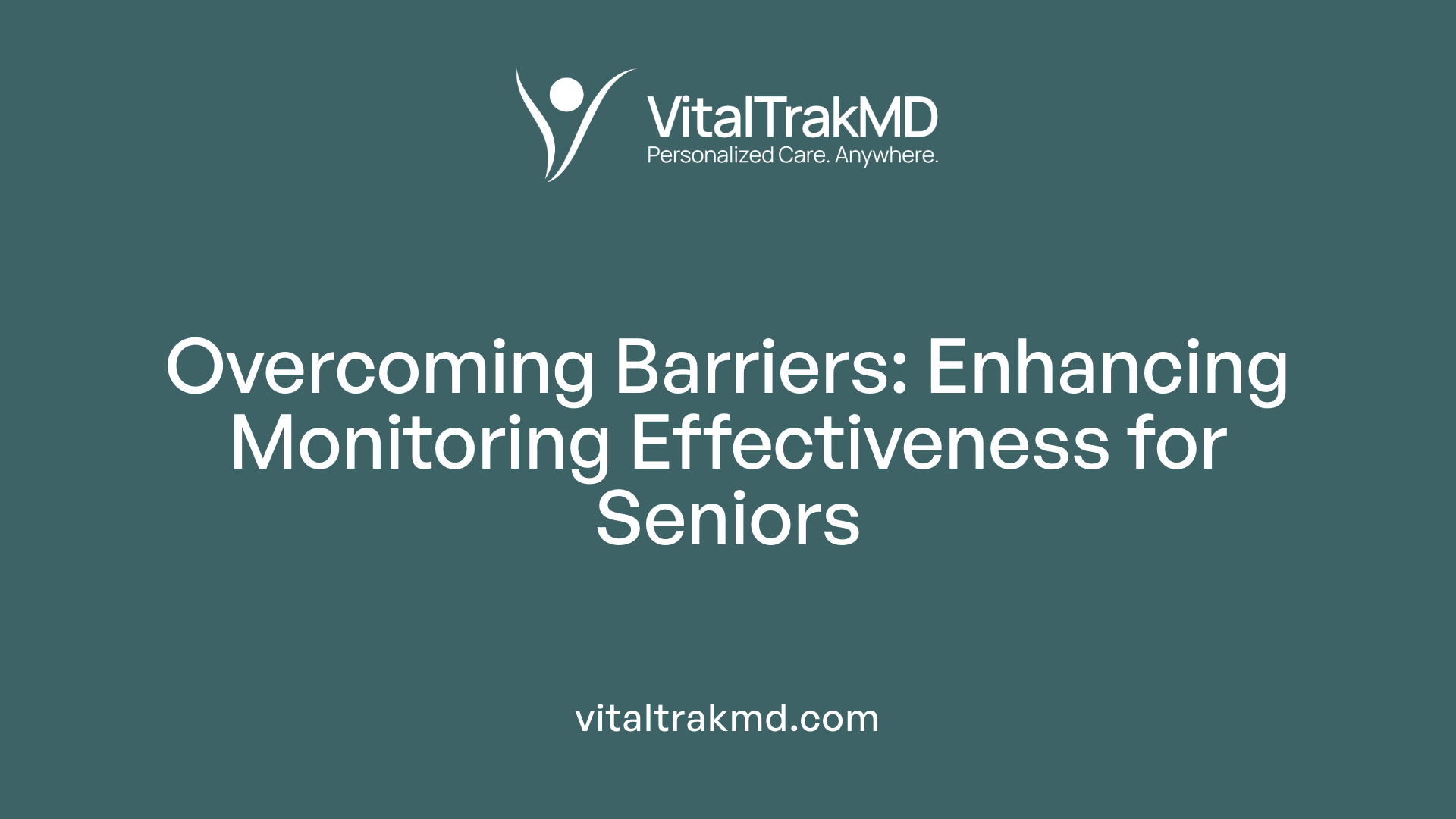
What are some challenges and limitations of current health monitoring systems for seniors?
While health monitoring technologies have the potential to significantly improve the care and independence of older adults, several limitations hinder their widespread and effective implementation.
One major challenge is the technological barriers faced by seniors. Many elderly users find it difficult to navigate complex interfaces or operate unfamiliar devices. This discomfort can lead to poor device usage or abandonment, negating the benefits these tools are meant to provide.
In addition, data overload poses a concern for healthcare providers. Continuous monitoring generates vast amounts of health data, which can be overwhelming to analyze without advanced data management and analysis tools. This may hinder timely interventions and strain clinical workflows.
Patient adherence and device compliance are also critical issues. Older adults may forget to wear sensors, charge devices, or follow prescribed protocols, reducing the accuracy and reliability of the monitoring system.
Privacy and security concerns are at the forefront of barriers to adoption. Sensitive health data transmitted and stored digitally raises fears about breaches, misuse, or unauthorized access, discouraging some seniors from fully engaging with these systems.
System usability issues further complicate adoption. Devices that are uncomfortable, difficult to set up, or incompatible with daily routines can discourage regular use. Moreover, poor integration with existing healthcare infrastructures impairs data sharing and coordination, limiting the effectiveness of remote monitoring.
Finally, the costs and reimbursement difficulties associated with these technologies deter both providers and patients. High device prices, lack of insurance coverage, and unclear reimbursement policies pose significant barriers.
Despite these limitations, ongoing advances in device design, validation, and system integration are essential to making health monitoring systems more accessible and effective for seniors.
| Limitation | Description | Impact |
|---|---|---|
| Technological barriers | Difficult interface and operational challenges for seniors | Reduced device usage, abandonment |
| Data overload | Excess data complicates analysis | Delays in response, provider burnout |
| Patient adherence | Forgetting or refusing to use devices | Inaccurate monitoring |
| Privacy/ security | Concerns about data breaches | Reduced user trust |
| Usability issues | Comfort and ease of use | Lower adoption rate |
| System integration | Poor connectivity with healthcare systems | Fragmented data, inefficient care |
| Costs and reimbursement | High device and service costs | Limited access and scaling |
Addressing these obstacles requires a multi-faceted approach that emphasizes user-centered design, secure data handling, and flexible healthcare policies. Continued research and development will help translate technological potential into practical, everyday solutions for aging populations.
The Significance of Consistent Monitoring for Safety and Well-being

How do irregular health data collection and monitoring impact elderly health management and safety?
Irregular health data collection and monitoring can greatly hinder effective health management for older adults. When data is inconsistent or incomplete, medical providers may lack a comprehensive picture of the individual’s health status. This can lead to delays in diagnosing conditions like arrhythmias, infections, or the risk of falls.
For example, if vital signs such as heart rate or blood pressure are not monitored regularly, early warning signs of deteriorating health might be missed. As a result, urgent medical interventions are delayed, increasing the chance of emergencies. This is especially critical for seniors managing chronic conditions where timely treatment is vital.
In addition, unreliable data can erode trust in health monitoring technologies. If an elderly person perceives that their devices are inaccurate or produce false alarms, they may become hesitant to use them consistently. This decreases the overall effectiveness of monitoring systems designed to alert caregivers or medical staff if problems arise.
Privacy concerns also play a significant role. Many older adults worry about how their personal health information is shared and stored. Fear of breaches or misuse can discourage full participation in continuous monitoring programs.
Consistent, accurate, and privacy-preserving health data collection is essential. It ensures timely health interventions, reduces emergency risks such as falls or sudden illness, and maintains the elderly person’s confidence in health monitoring tools.
Improving the reliability and privacy of health data collection can enhance safety, promote independence, and ultimately improve quality of life for seniors. Regular monitoring supports proactive health management, enabling early detection and treatment of emerging health issues.
Advancing Technology for Better Continuous Monitoring
What are some technological approaches to improve continuous health monitoring for seniors?
Modern technology offers various innovative solutions aimed at enhancing the health and safety of older adults through continuous monitoring. Wearable sensors, such as smartwatches and wristbands, are commonly used to track vital signs like heart rate, blood pressure, oxygen saturation, and physical activity levels. These devices provide real-time data that can alert caregivers or healthcare providers to emergencies, falls, or health deterioration.
In addition to wearables, ambient intelligence systems integrated into smart homes play a crucial role. These environments utilize a network of sensors embedded in everyday objects to monitor residents' activities, detect unusual behaviors, and ensure safety. For instance, passive infrared (PIR) motion sensors or contact sensors on doors and beds help understand daily routines and identify potential issues early.
Assistive robots and social companions are expanding the scope of health monitoring by providing social interaction and cognitive support. Robots like social robots or assistive aides can engage seniors in conversations, remind them to take medication, and monitor mental and emotional well-being, thus addressing loneliness and cognitive decline.
Telehealth platforms further extend healthcare access, enabling remote consultations, monitoring, and management. Systems such as the UC Davis I-Care facilitate ongoing interaction with healthcare professionals, providing tools for managing chronic illnesses or cognitive impairments from the comfort of home.
Emerging unobtrusive sensors, including contactless technologies and advanced imaging, complement these efforts by collecting comprehensive health data without interfering with daily life. Innovations like virtual reality environments and environmental sensors are being developed to personalize and scale health assessments, ensuring ethical considerations and user comfort.
Together, these technological approaches create a layered, scalable, and ethical framework for continuous health monitoring tailored to the diverse needs of seniors. They improve early detection, promote independent living, and reduce the burden on healthcare systems.
Perceptions and Acceptance of Health Monitoring Technologies by Seniors
What are elderly users' perceptions of health monitoring technologies, and how can acceptance be improved?
Older adults generally view health monitoring devices positively when these tools help enhance their safety, independence, and overall health management. Devices that are unobtrusive, easy to operate, and seamlessly integrate into daily routines are particularly appreciated. For example, wearable sensors like smartwatches or contactless sensors that monitor vital signs without requiring active user input are often well-received.
Privacy concerns, although present, tend to be less significant if users see direct safety benefits from monitoring and trust that their data is handled responsibly. Many are comfortable sharing health data with healthcare providers as long as they feel in control of their information, including options to review, edit, or restrict access.
To foster acceptance, device designers should focus on creating intuitive interfaces and straightforward usage procedures. Demonstrating clearly how the technology can improve health outcomes and maintaining transparency about data use builds trust. Tailoring device features to address individual privacy preferences—such as customizable data sharing permissions—helps users feel more in control.
Involving older adults in the development process ensures that their specific needs and concerns are considered, which increases comfort and willingness to adopt new technologies. Educational initiatives and user support, including tutorials and technical assistance, further facilitate familiarity and confidence in using these systems.
Overall, aligning technological solutions with the values, preferences, and daily realities of seniors is essential. When health monitoring tools are perceived as supportive, trustworthy, and respectful of independence, acceptance rates increase, leading to better health outcomes and improved quality of life for the elderly community.
Design Strategies for Better Senior Health Technologies
What strategies can enhance the effectiveness of health monitoring in senior care?
Improving health monitoring systems for older adults requires a focus on simplicity, comfort, and relevance. User-centered design is fundamental, emphasizing the need to create devices that are easy to operate and comfortable to wear, ensuring they fit seamlessly into daily routines.
Ease of use and comfort are critical features valued by seniors. Devices like wearable monitors should be waterproof, lightweight, and have intuitive interfaces. Features such as automatic data logging, long battery life, and simple synchronization with smartphones increase usability. Discomfort or complicated processes can discourage consistent use, so addressing these issues enhances long-term engagement.
Features valued by seniors include reliable health measurements, aesthetic appeal, and minimal maintenance requirements. Users prefer devices that do not interfere with regular activities, are discreet, and provide clear feedback or alerts. Incorporating functionalities like fall detection, heart rate monitoring, and location tracking supports both health safety and independence.
Addressing usability barriers involves involving older adults early in the design process to understand their preferences and limitations. Providing comprehensive training, technical support, and social encouragement helps foster trust and competence. Addressing concerns around privacy and data security also builds confidence in using digital health tools.
Strategies to enhance effectiveness encompass integrating monitoring systems with healthcare providers’ platforms to facilitate timely interventions. Employing iterative, evidence-based quality improvement methods such as Plan-Do-Study-Act (PDSA) cycles and Lean approaches allows continuous refinement of technology and processes.
Collaboration among multidisciplinary teams—comprising healthcare professionals, engineers, designers, and caregivers—ensures that devices meet medical and user experience standards. Furthermore, ongoing data analysis and benchmarking can identify areas for enhancement, ensuring the technology remains relevant and effective.
Ethical considerations, such as preserving social interaction and autonomy, are also paramount. Designing technologies that support social bonds, respect older adults’ control over their data, and enable independent living contributes to holistic well-being.
Summary of Design Approaches
| Aspect | Strategy | Benefit |
|---|---|---|
| User-Centered Design | Engage seniors in design process | Devices meet actual user needs |
| Comfort & Wearability | Use lightweight, waterproof materials | Increased compliance |
| Feature Relevance | Incorporate fall detection, GPS | Supports safety and independence |
| Usability & Support | Provide training, tech help | Enhances confidence |
| Data & Privacy | Ensure secure, transparent data handling | Builds trust |
| Continuous Improvement | Utilize PDSA, Lean methods | Keeps system effective |
These strategies help develop health monitoring systems that are not only functional but also embraced by older adults, fostering sustained use and improved health outcomes.
Toward a Holistic and Ecological Approach to Elderly Monitoring
What are some technological approaches to improve continuous health monitoring for seniors?
Advancements in technology have transformed how we monitor the health of older adults, focusing on continuous, unobtrusive, and comprehensive approaches. Wearable sensors stand at the forefront, collecting vital signs such as heart rate, blood oxygen levels, body temperature, and activity metrics like steps found in smartwatches and wristbands. These devices can detect anomalies, falls, and emergencies in real-time, offering immediate alerts.
Beyond wearables, ambient intelligence systems integrate sensors into the living environment, including PIR motion sensors, door sensors, sleep sensors, and ultrasonic location detectors. These sensors work together within smart home ecosystems to monitor daily routines, detect behavioral changes, and assess physical and cognitive health.
Assistive robots and social robots also contribute, providing social interaction, cognitive engagement, and support for daily activities. They help in reducing loneliness, encouraging physical activity, and giving cognitive exercises. Telehealth platforms enable remote access to healthcare providers, offering consultative and therapeutic support for managing chronic diseases, mental health concerns, and cognitive decline.
Emerging approaches involve virtual reality (VR) and unobtrusive sensors that seamlessly integrate into the home's environment, supporting personalized health assessments without disrupting daily life. Such systems emphasize scalability, ethical data collection, and user-centered design, ensuring older adults' acceptance and effective use.
By merging these technologies into comprehensive, adaptable systems, we can significantly improve the quality of life, safety, and independence of seniors while enabling proactive healthcare interventions.
How do multimodal sensor integrations enhance health assessments?
Integrating multiple sensor types—including physiological, motion, environmental, and location sensors—creates a rich data landscape known as a digital exhaust. This comprehensive data captures physical activity, sleep patterns, cardiovascular health, and environmental context, allowing for more accurate and nuanced health assessments.
Machine learning algorithms process this multimodal data to identify patterns and predict potential health risks such as fall probability, frailty levels, depression, or cognitive impairment. When combined with demographic or clinical data, these digital measures refine the accuracy and relevance of health evaluations.
The multisensor approach addresses limitations of single-sensor systems, providing redundancy and cross-validation, thereby improving reliability even at home with varying environmental factors. This holistic monitoring supports early detection, customized interventions, and better understanding of how physical, social, and emotional health interact.
Why is personalized, adaptable system design crucial?
Given the diversity among the elderly population, flexible and personalized health monitoring solutions are essential. Systems must adapt to individual health conditions, daily routines, preferences, and technological familiarity.
Personalization involves adjusting thresholds, alert mechanisms, and interfaces based on user-specific data. For example, a system might calibrate activity thresholds for a senior with mobility issues or tailor cognitive exercises considering the user's baseline functioning.
Adaptability also means updating the system's analytical models as new data becomes available, ensuring continuous relevance and accuracy. User-centered design principles, including easy-to-use interfaces, aesthetic appeal, and automatic data logging, foster long-term acceptance.
How are real-world validation studies shaping elderly health monitoring?
Validation in real-world settings confirms that technological solutions are practical and effective outside controlled conditions. Studies involving older adults in their homes over extended periods—ranging from weeks to months—evaluate the system's accuracy, usability, and impact.
Results from these studies demonstrate high classification accuracies for health states, such as above 90% for fall risk or depression detection. They also gather user feedback to improve system design, addressing usability barriers, privacy concerns, and comfort.
Real-world validation fosters confidence among healthcare providers and users, promoting broader adoption. It also generates insights into the long-term effects, helping refine algorithms, sensor configurations, and intervention protocols.
| Technology Component | Functionality | Benefits |
|---|---|---|
| Wearable Sensors | Track vitals, activity, fall detection | Continuous, personal health data |
| Ambient Sensors | Monitor environment, movement patterns | Contextual insights, behavioral trends |
| Social and Assistive Robots | Cognitive and social support | Reduce loneliness, promote activity |
| Telehealth Platforms | Remote clinical consultations | Increased access, early intervention |
| Virtual Reality & Immersive Tech | Cognitive exercises, engagement | Improve mental health, cognitive function |
By integrating these elements, a resilient, comprehensive elderly health monitoring ecosystem can be established, moving toward more proactive, personalized, and ethical care strategies.
Emerging Digital Measures for Elderly Health Assessment
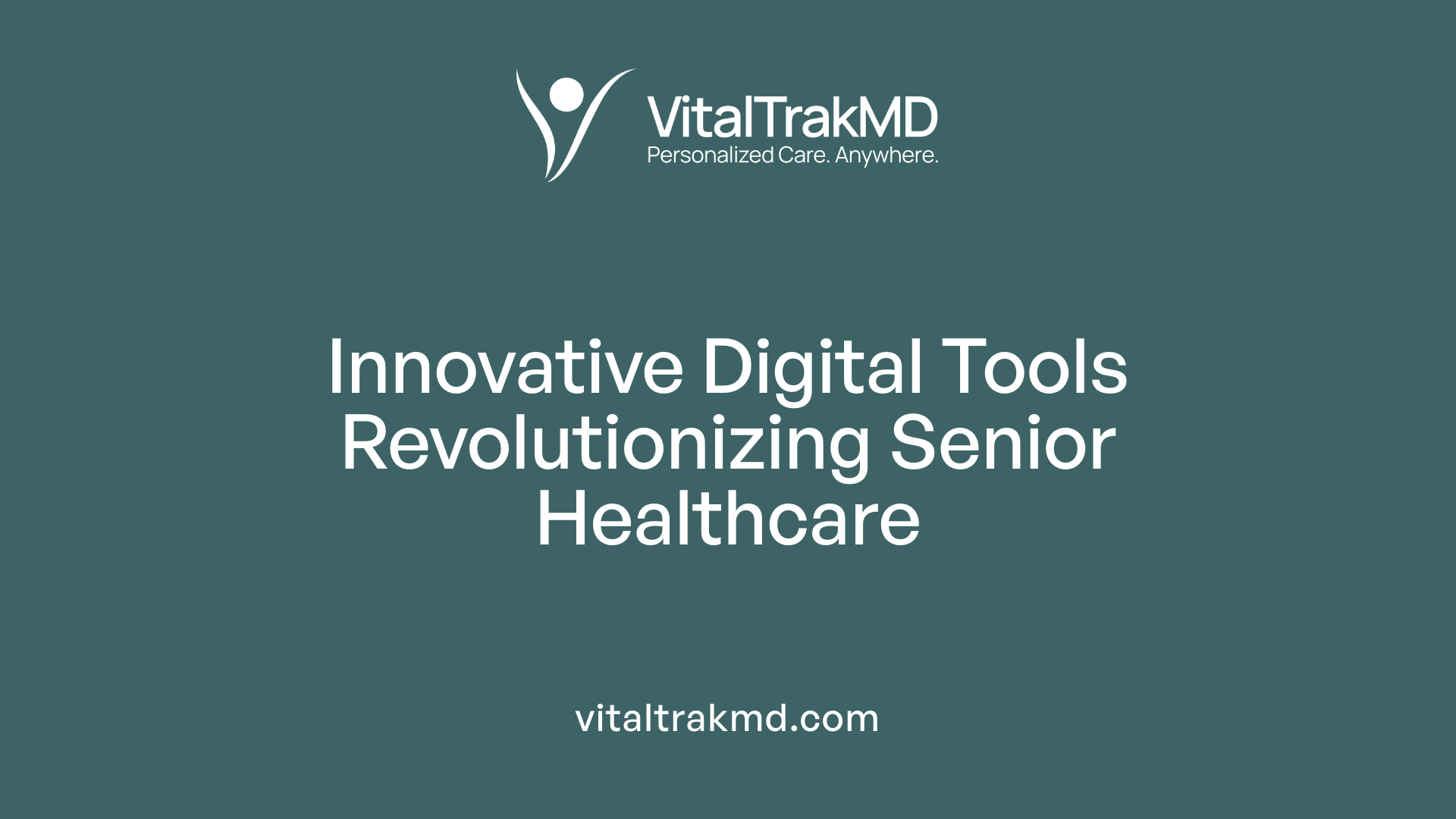
What are some technological approaches to improve continuous health monitoring for seniors?
To support seniors in maintaining health and independence, a variety of technological strategies have been developed. Wearable sensors, such as smartwatches or wristbands, play a critical role by continuously tracking vital signs like heart rate, blood pressure, oxygen saturation, and physical activity levels. These devices can detect falls, monitor sleep patterns, and even measure physiological stress markers, providing real-time data that can alert caregivers or health services about potential issues.
Ambient intelligence systems and smart home technologies further enhance safety by integrating environmental control with health monitoring. Sensors embedded in living spaces can observe daily routines, movement patterns, and environmental conditions, enabling early detection of anomalies or health deterioration.
Assistive and social robots are increasingly integrated into eldercare. These robots help with physical tasks, provide cognitive stimulation, and support emotional well-being by engaging with residents, addressing issues like loneliness and cognitive decline.
Remote health services, such as telemedicine platforms exemplified by UC Davis’ I-Care, facilitate access to healthcare professionals from the comfort of the home. These platforms support managing chronic conditions, medication adherence, and cognitive impairments through virtual consultations and data sharing.
Emerging technologies like virtual reality (VR) foster physical and cognitive therapy in engaging ways, while unobtrusive sensors—hidden in furniture or clothing—offer scalable, non-invasive monitoring.
Overall, these technological approaches aim to create personalized, ethical, and scalable solutions that improve health assessment, early intervention, and the quality of life for diverse older adult populations.
Addressing Privacy and Ethical Considerations in Elderly Monitoring
What are some challenges and limitations of current health monitoring systems for seniors?
Current health monitoring systems for seniors have demonstrated their potential to improve health outcomes by enabling early detection of problems, supporting self-care, and managing chronic diseases like COPD, heart failure, and diabetes more effectively. Despite these advantages, several challenges limit their broader adoption and effectiveness.
One major concern is data security and privacy. Many systems collect sensitive health data through wearable sensors and embedded devices, raising risks of data breaches and unauthorized access. Ensuring that this information remains confidential and protected against cyber threats is a critical challenge that needs ongoing attention.
Another issue involves informed consent and autonomy. As devices and apps collect continuous data, elderly users may not fully understand what information is being gathered or how it is used. It’s essential to empower users with clear information and control over their data, respecting their independence and decision-making rights.
Balancing safety with independence is also delicate. While monitoring aims to prevent accidents and health emergencies, excessive surveillance can infringe on personal freedom and privacy. Striking the right balance requires thoughtful system design that facilitates safety without overly intruding on daily life.
Financial barriers pose additional limitations. High costs of advanced monitoring devices and integrated systems can be prohibitive, especially for seniors on fixed incomes. Furthermore, reimbursement policies and healthcare system integration issues often hinder widespread deployment.
System usability is another hurdle. Many seniors face difficulty adapting to high-tech devices due to limited digital literacy, physical limitations, or discomfort with technology. Poor device design can lead to low adherence and ineffective monitoring.
Moreover, data overload is a significant challenge for healthcare providers who must interpret vast amounts of information generated by these systems. Efficient data management and analysis tools are necessary to turn raw data into actionable insights.
Finally, systemic issues such as the digital divide mean that not all seniors have access to reliable internet or modern devices, preventing equitable benefits from remote health monitoring.
Despite these challenges, the consensus among practitioners is optimistic. They believe that with continued technological advances, improved validation, and a focus on user-centered design, remote patient monitoring (RPM) will become an integral part of elderly care in the near future.
Addressing the ethical and privacy concerns is crucial for fostering trust and ensuring that technology serves the best interests of seniors. As the field evolves, a careful balance will be needed to harness technological benefits while respecting individual rights and societal values.
Systemic Gaps and Policy Perspectives
What are the main barriers to the adoption of health monitoring systems among older adults?
Many older adults face challenges in adopting health monitoring technologies due to a combination of usability issues, lack of familiarity with digital tools, and concerns over privacy and security. Technical complexity and unfamiliarity with smartphones or wearable devices can deter sustained use. Moreover, they may perceive these systems as intrusive or unnecessary, especially if they are not convinced of their benefits.
Financial barriers are significant; high costs of devices and ongoing service fees can limit access for many seniors. Additionally, some older adults live in areas with limited internet connectivity or lack digital infrastructure, which further hampers adoption.
There is also a digital divide where socio-economic status, education level, and geographic location influence the likelihood of utilizing health technologies.
Which are the financial and policy obstacles to implementing remote health monitoring?
Financial obstacles are among the highest barriers, associated with the costs of devices, subscription services, and maintenance. Reimbursement policies in many healthcare systems do not fully cover or incentivize remote monitoring solutions, discouraging providers and patients from using these technologies.
Policy hurdles include regulatory challenges, lack of standardized protocols for data privacy and security, and insufficient integration of digital health solutions into existing healthcare frameworks. There are also concerns over liability, data sharing, and ensuring interoperability across different systems.
Financial incentives and policy reforms are crucial to promote wider adoption, such as subsidies, insurance coverage, and supportive regulations that encourage innovation while ensuring safety and privacy.
What are some digital divide issues impacting elderly users?
The digital divide significantly impacts elderly populations as many may lack access to high-speed internet, smartphones, or digital literacy skills.
This disparity can lead to inequalities in health outcomes, with some seniors unable to benefit from the advantages provided by remote monitoring or telemedicine. Limited access often correlates with lower socio-economic status, residing in rural or underserved areas, or lacking technical support.
Efforts to bridge this divide are essential, including providing affordable devices, expanding broadband access, and offering training to improve digital skills among seniors.
Which strategies could improve policy and support wider adoption?
To address systemic gaps, policymakers can implement multifaceted strategies:
- Developing financial incentives like subsidies or insurance reimbursement for digital health devices.
- Standardizing regulations around data privacy, security, and interoperability.
- Investing in community-based digital literacy programs targeting seniors.
- Designing user-friendly devices tailored to the needs of older adults, emphasizing ease of use, comfort, and accessibility.
- Encouraging collaborations between healthcare providers, technology developers, and policymakers to create integrated solutions.
- Promoting public awareness campaigns highlighting the benefits and safety of health monitoring systems.
- Ensuring continuous evaluation and adaptation of policies based on technological advancements and user feedback.
How does policy influence the integration of health monitoring in elder care?
Policy frameworks shape the opportunities and barriers for integrating health monitoring systems into everyday elder care. Effective policies can facilitate funding, establish standards, protect privacy, and promote technological innovation.
Conversely, restrictive or unclear regulations may slow down adoption, create uncertainty, or lead to suboptimal implementation. Hence, adaptive, supportive, and inclusive policy environments are essential to harness the full potential of health monitoring technologies.
| Aspect | Challenges | Suggested Policy Actions | Impact |
|---|---|---|---|
| Financial | High costs; limited reimbursement | Subsidies; insurance coverage | Increased accessibility |
| Regulatory | Privacy, security, interoperability | Clear standards; secure data handling | Trust and wider acceptance |
| Infrastructure | Digital divide; lack of connectivity | Broadband expansion; digital literacy programs | Equitable access |
| User Acceptance | Usability, trust, motivation | User-centered design; training programs | Improved adherence |
| Integration | Fragmented health systems | Standardized data protocols | Seamless care delivery |
Addressing these barriers through targeted policy measures can significantly improve how health monitoring systems are adopted and utilized, ultimately supporting healthier and more independent aging populations.
Future Directions and Policy Recommendations
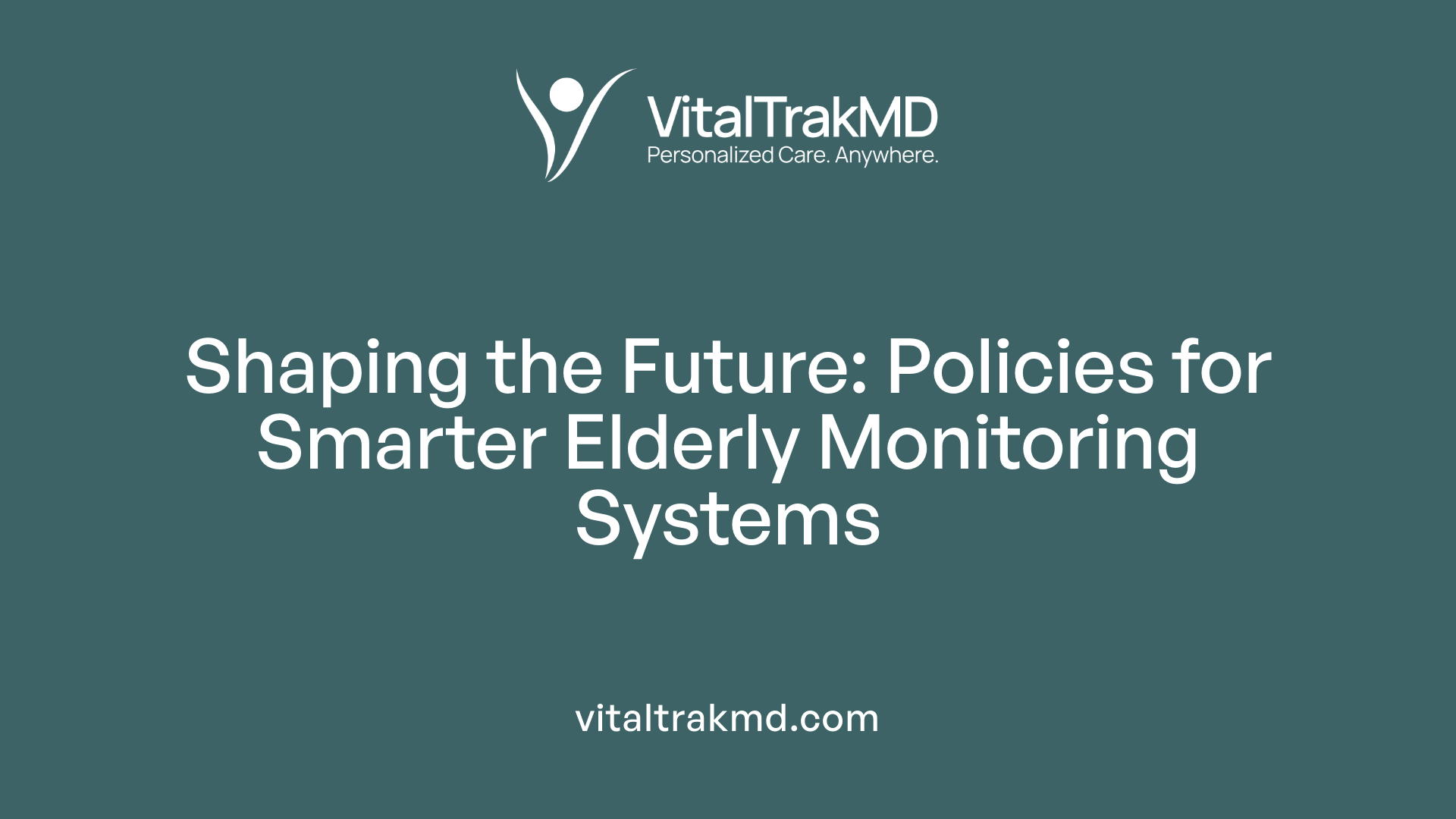
What strategies can enhance the effectiveness of health monitoring in senior care?
Enhancing health monitoring for older adults requires a combination of innovative technology design, systemic improvements, and policy support. One effective approach is to prioritize user-friendly device designs tailored to older adults' needs. Devices should be comfortable, easy to operate, and aesthetically appealing to promote acceptance and long-term use. Features such as waterproofing, automatic logging, long battery life, and compatibility with smartphones are highly valued.
Integrating data from sensors seamlessly into healthcare systems can enable timely interventions and ensure continuous care for managing chronic conditions like heart failure, COPD, and diabetes. This integration supports proactive health management and reduces the risk of hospitalization.
Employing participatory and iterative design processes—such as involving seniors in the development stages—can help create solutions that truly meet user needs. Incorporating evidence-based quality improvement methodologies like Plan-Do-Study-Act (PDSA) cycles and Lean principles allows for ongoing optimization of health monitoring systems, ensuring safety and efficiency.
Training caregivers and involving multidisciplinary teams—including healthcare providers, social workers, and engineers—ensure comprehensive support for users. This collaborative approach optimizes device usage, troubleshooting, and personalized interventions.
Ongoing data analysis and benchmarking against best practices facilitate continuous system improvement. Regular evaluation helps identify gaps and areas for enhancement, maintaining the relevance and effectiveness of monitoring programs.
Addressing ethical considerations is crucial. Technologies should support social interaction, preserve independence, and respect older adults’ autonomy. Privacy controls, transparent data policies, and user control over monitoring enhance trust and social acceptance.
Policy frameworks must also promote equitable access to health technologies, reducing barriers related to cost, digital literacy, and infrastructure disparities. Public health initiatives can include subsidy programs and training resources to ensure broader adoption.
Collectively, these strategies can transform senior health monitoring from sporadic and reactive efforts into a reliable, continuous, and socially supportive system that enhances quality of life and healthcare outcomes for the aging population.
Bridging the Gap in Elderly Health Monitoring
Addressing the challenges of sporadic and inconsistent health data collection is crucial to improving elderly care. Advances in sensor technologies, user-centered design, and integrated systems hold promise for real-time, continuous monitoring. A collaborative effort among developers, healthcare providers, policymakers, and seniors themselves is essential to overcome systemic barriers, enhance acceptance, and ensure safety. Only through a comprehensive, ethical, and adaptive approach can we transform elderly health monitoring from sporadic snapshots into reliable, ongoing support that promotes independence and enhances quality of life for aging populations.
References
- The Problem of Monitoring Activities of Older People in Multi ...
- The Problem of Monitoring the Psycho-Physical Condition of Seniors ...
- A systems approach towards remote health-monitoring in older adults
- Systematic design of health monitoring systems centered on older ...
- Older Adults' Experiences With Using Wearable Devices
- stakeholder perspectives in large-scale remote health monitoring for ...
- [PDF] Remote Health Monitoring Systems for Elderly People: A Survey
- IoT‐Based Elderly Health Monitoring System Using Firebase Cloud ...
Recent articles
Want to Feel Better and Live Healthier?
Join hundreds of patients taking control of their health with personalized care that fits their life – not the other way around.
Rated 4.8/5 by 32+ customers



